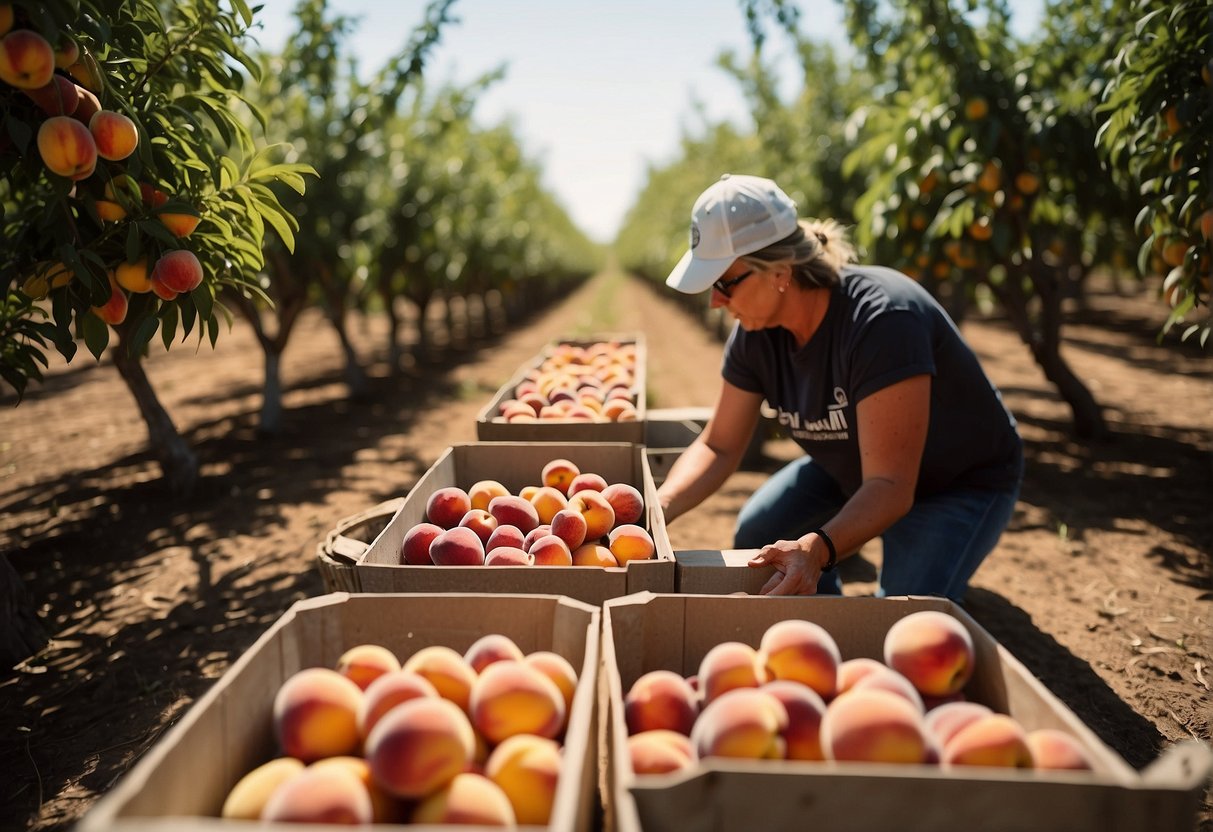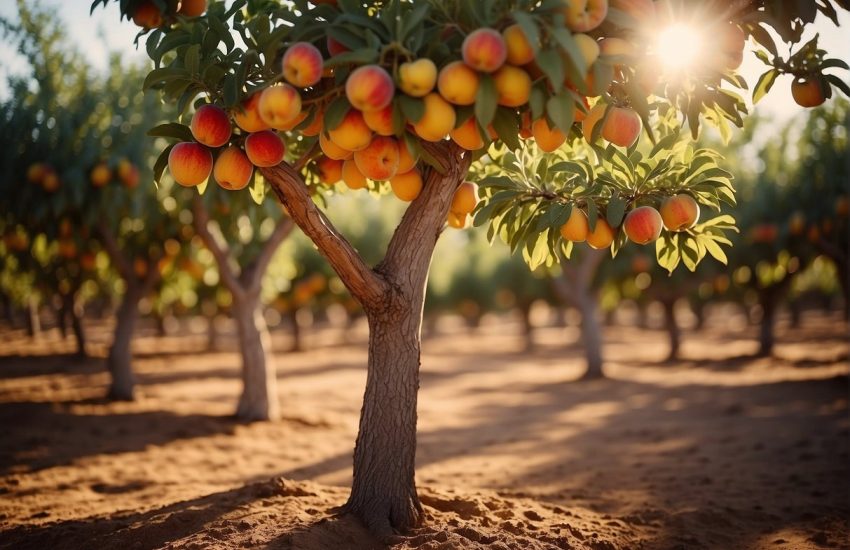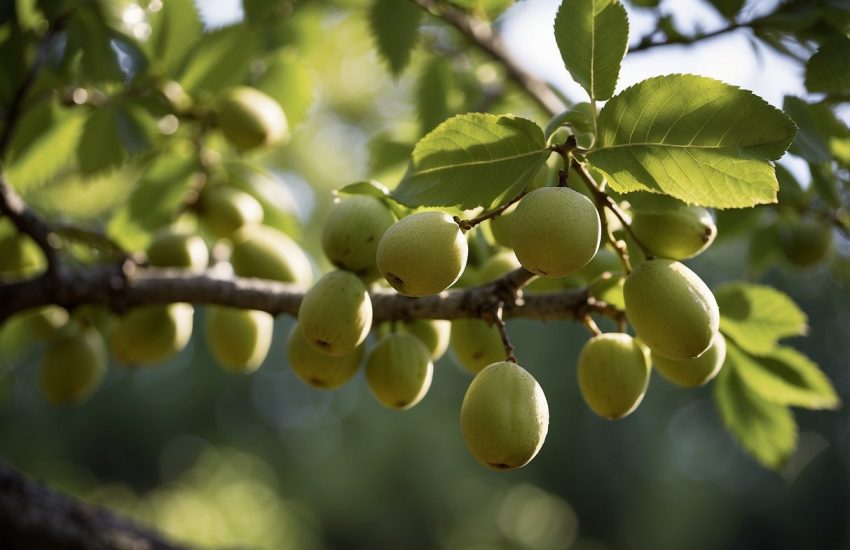Best Peach Trees for Texas: A Guide to Choosing the Right Variety for Your Garden
Peach trees are a popular fruit tree option for gardeners in Texas due to their delicious fruit and beautiful blossoms. However, with so many varieties available, it can be overwhelming to decide which peach tree to plant. In this article, we will discuss some of the best peach trees for Texas, taking into consideration factors such as disease resistance, fruit quality, and adaptability to Texas’ climate.

One of the most important factors to consider when choosing a peach tree for Texas is its ability to resist disease. Texas is known for its hot and humid climate, which can make peach trees more susceptible to diseases such as bacterial spot and peach leaf curl. Therefore, it is important to choose a variety that has good disease resistance. Additionally, fruit quality is another important consideration. Gardeners want a peach tree that produces flavorful, juicy fruit that is easy to harvest. Finally, adaptability to Texas’ climate is crucial. The best peach trees for Texas are those that can thrive in the state’s hot summers and mild winters.
Selecting the Right Peach Trees for Texas
When it comes to growing peach trees in Texas, selecting the right variety is crucial for success. With its varied climates and hardiness zones, it is important to understand the unique growing conditions in Texas before selecting a peach tree.
Understanding Texas Climates and Hardiness Zones
Texas has a diverse climate ranging from subtropical to arid. The state is divided into four hardiness zones, ranging from 6b to 9a. Central Texas, the Gulf Coast, and North Texas have different climates and soil types, which can affect the growth and production of peach trees.
It is important to choose a peach tree variety that is adapted to the specific hardiness zone and climate of the area where it will be planted. This will ensure that the tree will thrive and produce fruit.
Top Peach Varieties for Texas
There are several peach varieties that are well-suited for Texas climates. The Elberta peach tree is a popular choice for its large, juicy, and sweet fruit. The Redskin peach tree produces a smaller, but flavorful fruit that is ideal for canning and baking. The Contender peach tree is a hardy variety that produces a large, firm, and juicy fruit.
Other peach varieties that are suitable for Texas include the Flordaprince and Earligrande. These varieties are known for their early ripening and high yields.
Chilling Requirements and Texas Weather Patterns
Peach trees require a certain amount of chilling hours to produce fruit. Chilling hours are the number of hours that a tree is exposed to temperatures between 32 and 45 degrees Fahrenheit during the dormant period.
In Texas, the weather patterns can vary greatly from year to year, with some years being warmer or colder than others. It is important to choose a peach variety that has a chilling requirement that matches the average number of chilling hours in the area where it will be planted.
In conclusion, selecting the right peach tree variety for Texas requires careful consideration of the climate, hardiness zone, and chilling requirements. By choosing a variety that is well-suited for the area, growers can ensure a successful harvest of delicious and juicy peaches.
Cultivation and Care of Peach Trees
Peach trees are a great addition to any garden or orchard in Texas. They are relatively easy to grow and maintain, and with proper care, they can produce a bountiful harvest of delicious fruit. In this section, we will cover the essential aspects of cultivating and caring for peach trees in Texas.
Planting and Site Selection
When planting peach trees, it is essential to select a suitable site that receives full sun exposure and has well-draining soil. Peach trees prefer sandy loam soil that is rich in organic matter. The ideal pH range for peach trees is between 6.0 and 6.5. It is recommended to plant peach trees in the late winter or early spring, when they are still dormant.
The spacing between peach trees should be between 15 to 20 feet, depending on the variety. Before planting, it is crucial to prepare the soil by digging a hole that is twice the size of the root ball. The root ball should be placed in the hole, and the soil should be backfilled around it.
Watering and Moisture Management
Peach trees require regular watering, especially during the first few years of growth. It is recommended to water peach trees deeply once a week, providing 10 to 20 gallons of water per tree. Drip irrigation is an excellent option for watering peach trees, as it delivers water directly to the root zone, reducing water waste.
Moisture management is crucial for peach trees, as they are susceptible to root rot if the soil remains too wet. It is essential to ensure that the soil is well-draining and not waterlogged.
Pruning and Training Peach Trees
Pruning is an essential aspect of peach tree care, as it helps to promote healthy growth and fruit production. It is recommended to prune peach trees in the late winter or early spring, before new growth begins. Pruning should focus on removing dead, damaged, or diseased wood, as well as thinning out the branches to allow for better air circulation.
Training peach trees is also crucial for promoting healthy growth and fruit production. It is recommended to train peach trees to a central leader system, which involves selecting a single, dominant trunk and removing any competing branches.
Fertilization and Nutrient Requirements
Peach trees require regular fertilization to maintain healthy growth and fruit production. It is recommended to fertilize peach trees in the early spring, before new growth begins. A balanced fertilizer, such as a 10-10-10 NPK fertilizer, is ideal for peach trees.
In addition to fertilization, peach trees require specific nutrients, such as nitrogen, phosphorus, and potassium. It is recommended to conduct a soil test to determine the nutrient requirements of your peach trees.
In conclusion, cultivating and caring for peach trees in Texas requires proper site selection, watering, pruning, and fertilization. With these essential aspects in mind, you can enjoy a bountiful harvest of delicious peaches from your own backyard.
Protecting Peach Trees from Pests and Diseases

Peach trees are susceptible to a variety of pests and diseases that can cause significant damage to the crop. Proper management and prevention techniques can help mitigate the risk of crop loss and maintain a healthy orchard.
Common Pests and Insect Management
Peach tree borers, scale insects, and aphids are some of the most common pests that affect peach trees in Texas. These pests can cause damage to the tree’s bark, leaves, and fruit, leading to reduced fruit quality and yield.
To manage these pests, it is important to regularly monitor the orchard and implement appropriate control measures. This may include the use of insecticides, cultural practices such as pruning and weed control, and biological controls such as natural predators.
Disease Prevention and Control
Peach leaf curl, bacterial spot, and brown rot are some of the most common diseases that affect peach trees in Texas. These diseases can cause leaf and fruit damage, reduced fruit quality, and even complete crop loss.
To prevent and control these diseases, it is important to implement proper sanitation practices, such as removing infected plant material and avoiding overhead irrigation. Fungicides may also be used in some cases to control disease outbreaks.
Weather-Related Challenges
Texas weather can pose a challenge for peach production, particularly late spring frosts and drought conditions. Late spring frosts can damage blossoms and reduce fruit set, while drought conditions can stress the tree and reduce fruit quality and yield.
To mitigate the impact of these weather-related challenges, it is important to select cold-hardy cultivars and implement proper irrigation and soil management practices. Additionally, covering trees during late spring frosts can help protect blossoms and ensure a successful crop.
In conclusion, protecting peach trees from pests and diseases requires a combination of proactive management techniques, proper sanitation practices, and careful attention to weather conditions. By implementing these strategies, peach orchards in Texas can maintain healthy trees and a productive crop.
Harvesting and Utilizing Texas Peaches

Texas is known for its juicy, sweet peaches, which are typically harvested from May to June. Whether you have a few peach trees in your backyard or a larger orchard, it’s important to know the best techniques for harvesting and utilizing your fruit.
Thinning and Harvesting Techniques
To ensure that your peaches grow to their fullest potential, it’s important to thin the fruit when they are still small. Thinning helps to prevent overcrowding and allows the remaining fruit to receive more nutrients and sunlight. This can be done by simply plucking off the smaller fruit, leaving only one or two larger peaches per branch.
When it comes time to harvest your peaches, it’s important to do so at the right time. The best way to determine if your peaches are ready to be picked is by gently squeezing them. If they give slightly, they are ready to be harvested. Be sure to pick them carefully, as they bruise easily.
Peach Uses: From Baking to Preserving
Once your peaches have been harvested, there are many delicious ways to utilize them. Baking is a popular option, with peach cobbler and peach pie being classic favorites. Peaches can also be used in jams, jellies, and other preserves.
For those who prefer to enjoy their peaches fresh, there are two main types to choose from: clingstone and freestone. Clingstone peaches have flesh that clings tightly to the pit, while freestone peaches have flesh that easily separates from the pit. Freestone peaches are typically easier to work with in the kitchen, as the pit can be easily removed.
In Texas, peaches are a beloved fruit that can be enjoyed in a variety of ways. By utilizing the proper techniques for thinning and harvesting, as well as exploring different peach uses, you can fully enjoy the bounty of your fruit trees.


